Philly Leaps into Today
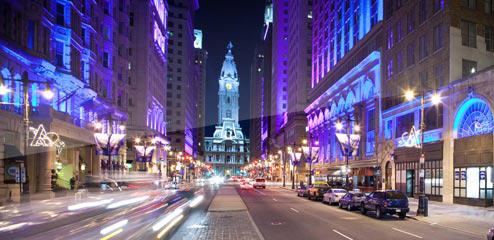
I recently had the pleasure of visiting Philadelphia for the first time as an attendee of the American Theatre Critics Association (ATCA) Conference. I raced through those days of conference activities, burnished by a plethora of exciting new and newly-imagined works for the stage. If Philly is so steeped in American History that it feels impossible to imagine a trip there without the imperative headset tour, then book your flight and take in a theatre scene that is anything but stodgy, or “steeped” while you get your history lesson. I took in the re-visitation of a play by a would-be successor to Anton Chekhov, a child’s play for adults, a theatrical exploration of the sci-fi sexual politics of an evolving internet (with the potential of virtual child-exploitation), the blending of an antebellum love story across race lines with another play so racially in-your-face that race almost disappears, and finished up with a play about accidental cougar-ing. Stodgy indeed, John Adams.
***
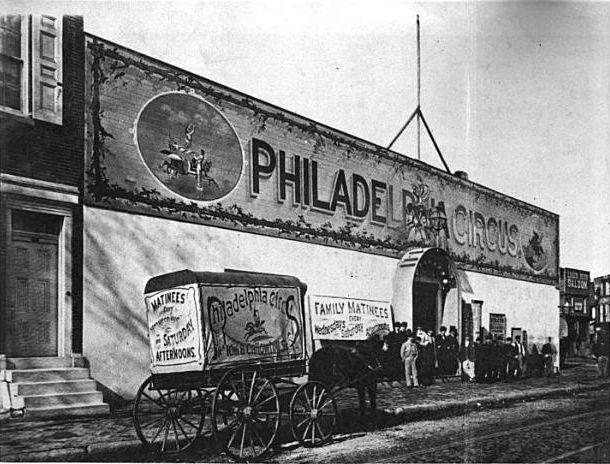
He Who Gets Slapped
I tucked into an alleyway next to a stunning old church, across Broad Street from as new a building as the church was wizened, as ablaze with lights and as crawling with people as my secret pathway was dark and quiet. Escorted by a member of the theatre’s crew, I then entered into the parish hall in which the play was staged, so beautifully festooned with draperies and all things circus that I didn’t catch its true identity for several minutes.
And so I began my Philadelphia sojourn with Leonid Andreyev’s He Who Gets Slapped, produced by The Philadelphia Artists’ Collective in partnership with The Philadelphia School of Circus Arts. Not only is the play an elegiac choice of programming, as Andreyev’s work is little-known, but the addition of actual circus practitioners to tell a little-top tale brings a cutting edge to this offering.
The story is contained in the emotional center ring of a small circus, where the performers, management, and hangers-on vie for power and fulfillment of social and carnal desire. While Papa Briquet is the ostensible owner of the circus, feline-with-a-bullwhip Xena controls not only the money, but Briquet’s briquettes. The star of the circus is bareback rider Consuelo, ostensibly the daughter of Count Mancini. The Count is given to liaisons with underage young women, and intends to broker the marriage of his daughter to the wealthy Baron in order to pay off the parents of his indiscretions and stay out of jail. Consuelo’s circus partner Bezano is perhaps in love with her, and she, perhaps, is in love with him. The clowns Wally and Paulie race about, indicating, changing sets, and as befits their profession, lightening the mood.
Into this circle steps a man who begs to be taken on as a clown. Obviously well-bred and educated, he is at first shunned by the circus folk, as he has no experience. Papa Briquet and Xena are concerned about the legal implications of employing a player who refuses to give his name. The man finally begs and bribes his way in, and eventually ends up getting slapped, which is found amusing to his new kin. The slaps are added to the clown acts, and the man who is actually the disillusioned writer “Paul,” becomes the “He” in the play’s title.
The Baron is persuaded to marry Consuelo, which she accepts nonchalantly, as a matter of her Fate. But He believes this pendulum can be thwarted, and begs her to either run away with Bezano, or to run away with him, because He is also in love with her. When she insists on running Fate’s course, He sets her free by poisoning her drink, finishing the cup himself, thereby insisting on agency over predestination.
The character of “He” embodies the central themes of Andreyev’s output, centering on the notions of Fate and Chance, given the potential agency of choice. Andreyev’s use of romanticism and symbolism are highlighted by a series of circus acts. Unexpected, well-executed, and exhilarating, they change the dynamic from the spoken to the pantomime and take the audience on a stroll away from stage naturalism, of which Andreyev was a strong opponent. Musical interludes and underscoring added both comedy and pathos. The entire cast played in the band at one point or another, with varying levels of competency and noticeable pleasure, shuffling reality’s deck of cards.
The actors were mishmashes, as appropriately mismatched as to be expected in Andreyev’s unreal context; their mixture of skills, with some more obviously proficient at acrobatics, added an appropriate sense of disruption. Bob Weick’s Papa Briquet was the right mixture of power and simper, and Annete Kaplafka’s Xena owned the stage in her every moment. Nathan Foley, Ben Grinberg, and Brian McCann created sufficiently surreal characters. As the clowns, Josh Totora (also the musical director) and Andalyn Young were simply terrific.
With its mix of actors, musicians, acrobats and clowns, The Philadelphia Artists’ Collective and The Philadelphia School of Circus Arts brought a lesser-known, esoteric playwright’s work to Philadelphia’s theatre audiences in an accessible way, and prepared me for the magic of the city’s eclectic theatrical season.
***
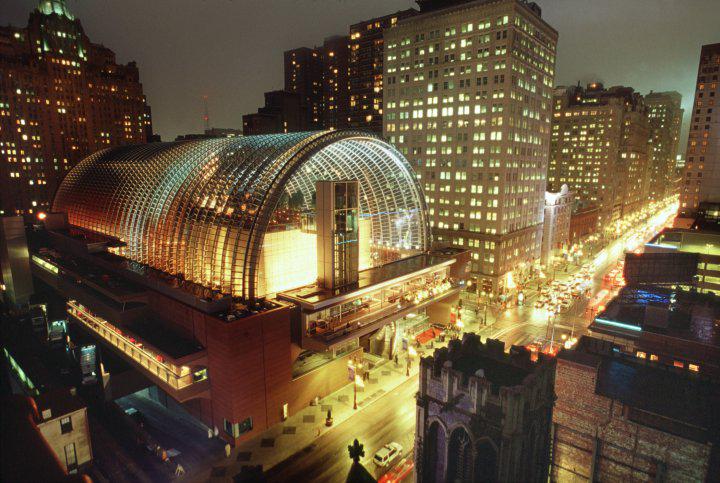
The contemporary building across the street was fairly exploding with sounds of merriment as I stumbled out of the church’s womb and onto the sidewalk of Broad Street. I stopped short, adjusted my glasses, and wondered about the potential side effects of overly-quick physical displacement. For there, rearing and cavorting, pawing at the median strip in the center of Broad Street was a line of huge white horses. It was several hard-earned breaths before my easily cancelled disbelief allowed me to see that these were giant helium-powered puppets, riding on the seemingly ant-like shoulders of dancing acrobats.
***
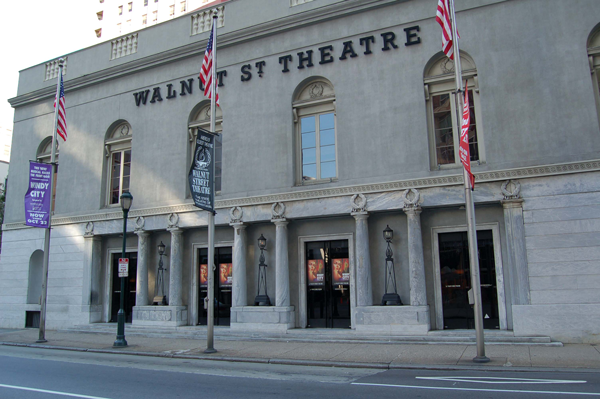
Peter and the Starcatcher
I could have spent my day wandering around The Walnut Street Theatre, looking at the pictures and the posters. If there is a “cornerstone” to the Philadelphia theatre scene it may well be The Walnut, the oldest theatre in the country, its history connected to both the famous and the infamous, from the Barrymores to the Booths.
There must have been a lass and her Peter Pan before Mary Martin’s famous crowing, hence the story of Peter and the Starcatcher. The novel by Dave Barry and Ridley Pearson, adapted to the stage by Rick Elice, is the long-delayed, thankfully remembered prequel to J. M. Barrie’s Peter Pan and Wendy. Directed by Bill Van Horn, Walnut’s production suffered from an embarrassment of riches in the design: Todd Edward Ivins’ sets, J. Dominic Chacon’s lighting, and Mary Folino’s costumes were in glorious evidence. Wayne Barker’s music was well delivered as honed by music supervisor and castmate Alex Bechtel.
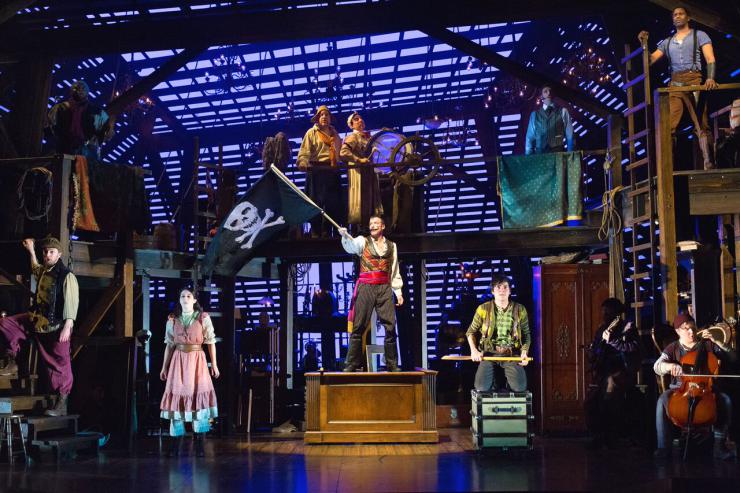
The story that sends Peter to Neverland and sets the stage for Tinkerbell and the next generation’s Wendy begins with two ships, both bound for Rundoon, and two trunks. One ship is a Right Honorable vessel, meant to carry the Queen’s trunk, full of starstuff, as escorted by her attaché and secret agent Lord Aster. The other is a dawdling, unfortunate little vessel, captained by a nasty fellow who switches the trunks. Lord Astor leaves his daughter Molly on the slower-moving vessel, which also houses three boys, including one Peter, who have been sold into slavery. A pirate with a big black mustache shows up, the starstuff ends up in a pool, Peter falls in, and it turns out that once you’ve been dipped in starstuff you grow no further than the age you’ve reached. Throw in a pantomime dame, and a ships galley of rotating, salivating pirates, thieves, and their apparent betters, and we have an adult tale of childhood whimsy, sure to bring a blush in the dark of the theatre’s hidden heart to the cheek of the saltiest corporate pirate.
Walnut’s production is chockful of talented fellows, many of whom rotate in and out of the theatre’s productions and seasons, creating a sort of core-company, in fact if not in name. All of the gents have charisma, and the vocal and physical chops for a piratical trip. As Peter, Brandon O’Rourke shows particular charm and promise. But all are eclipsed by the sole female, Michaela Shuchman, who gives a transcendent performance as Molly.
Dame Comedy can be an unforgiving mistress. If you treat her just right, the players and their audience will connect viscerally in the shared guffaw that comes after the several wait-for-it, wait-for-it, under-the-breath giggles that proceed.
Dame Comedy can be an unforgiving mistress. If you treat her just right, the players and their audience will connect viscerally in the shared guffaw that comes after the several wait-for-it, wait-for-it, under-the-breath giggles that proceed. Easily the most “commercial” of the Philly plays I took in, Peter and the Starcatcher was a few hours well-spent in the hold of the good ship Walnut. Philly’s theme of new audience-enticing programming, presented in accessible ways, remained intact in my mind.
***
At the end of Starcatcher, Peter was compensated with the gift of flight, and that brought me around to thinking about my white steeplechasers. I’d learned that they were part of the entertainment for the PIFA Gala at The Kimmel Center for the Performing Arts, a black tie event where Rhiannon Giddens was joined by French performance troupe Compagnie des Quidams, performing their unique show FierS à Cheval, or “Proud Horse”—an interactive show with a fantastical group of inflatable horse puppets! I’d arrived in time for the third installment of the Philadelphia International Festival of the Arts at The Kimmel Center, taking place across the venues of the Kimmel Center’s campus, as well as select locations throughout the city. This sixteen-day celebration of art and community showcased a breadth of local and international performances and installations, all curated by the Kimmel Center for the Performing Arts. Oh, for a little more time! And my tuxedo!
***

The Nether
Have you ever wondered at the fury with which an otherwise mild-mannered child of your acquaintance can pound away with malicious glee as she or he maligns, mangles, or murders glowing bits of data dancing across a computer screen? Now imagine an interactive computer game in which your personal avatar, chosen by someone else, has been placed. You don’t have a computer mouse or a keyboard to contribute to the drama. The only rule is that here there are no rules. Jennifer Haley’s play, The Nether is wildly current, and as provocative as television’s Law & Order: SVU. InterAct Theatre’s decision to present the 2013 sci-fi drama is exactly in keeping with the bit-in-the-teeth theatrical galloping I witnessed in Philly.
InterAct has segmented the former ballroom of Philadelphia’s Drake Hotel into two playing spaces, and has taken on four other theatres as “Residential Partners,” placing itself directly in the Philly’s theatre district, while reapportioning an historic space. Lobbies were still under construction during my visit.
“InterAct is a theatre for today's world, dedicated to commissioning, developing, and producing new and contemporary plays that explore the social, political, and cultural issues of our time,” reads the company’s mission.
Set in a time so close to possible that we can almost squint and see it, the internet has become “The Nether,” with such freedom of choices that the notion of appropriate policing of regions of various realities is called up. In an online place called The Hideway, pedophiles bed and breed children of their choice and then, if it entices them further, dismember their prey. Of course, it is all virtual, and no one is hurt, because the pedophiles are exercising their sexual dementia in a controlled venue, and if all the parents in the world are paying attention, the “children” are other consenting adults, enjoying the game. Right?
Director Seth Rozin’s cast of Bi Jean Ngo, Greg Wood, Tim Moyer, Griffin Stanton-Ameisen, and Emi Branes-Huff all commit themselves well, and designers Melpomene Katakalos (scenic), Maria Shaplin (lighting), Janus Stefanowicz (costumes), and Rob Kaplowitz (sound) create individual spaces in which audiences are invited to experience a horrifying sense of complicity.
I find The Nether the sort of sparkling conversation that will bring new viewers to our theatres, and convince them that leaving home to get a taste of disconnection from their daily lives by looking at live people on a stage rather what have become specks of data on a television screen is exciting and viable.
***
If Philly is so steeped in American History that it feels impossible to imagine a trip there without the imperative headset tour, then book your flight and take in a theatre scene that is anything but stodgy, or ‘steeped’ while you get your history lesson.
An Octoroon
The Wilma Theater moved into its home at Broad and Spruce in 1996, its zig-zagging neon sign shouting “Wilma!” in all directions. With a $10 million “Transformation Fund” in play, updates are in store, but that high-flying sign will remain. With a history of bringing new writers to the scene, and then empowering their work through collaboration, it is no surprise to see Branden Jacobs-Jenkins’ An Octoroon in their season.
A riff on the nineteenth-century Dion Boucicault melodrama The Octoroon, the narrative flashes between that antebellum love story and a playful examination of the history of the theatre. And then the two intertwine. The comedy is transgressive, uncomfortable, even disquieting at first, until the strictures of polite-speak dissolve, and a story can be shared. White actors appear in black face, black actors in white face, and there is red face paint for the Indian. The three slave women talk as saucy as Queen Latifah, and the band in the background plays everything from hip-hop to the Stephen Foster-esque.
With a team of first-rate performers playing multiple roles, mixing race and gender in news ways that can’t help but create dialogue, here we have another example of Philly’s in-your-face-brother investigations.
***
Sex With Strangers
The most altogether successful production I caught on my trip to Philly was the Philadelphia Theatre’s Sex With Strangers, at the Suzanne Roberts Theatre. Able to court both a more established theatre-going crowd while ushering in the folks who learned about cougar-ism from Courtney Cox’s television portrayal, Sex With Strangers pulses with heart, matching its comic sensibilities.
Playwright Laura Eason creates a seemingly inequitable yet whimsically similar pair, both flawed, both hidden away in themselves, and passing the roles of protagonist and antagonist back-and-forth. Director David Saint guides Kyle Coffman and Joanna Rhinehart to accessible, yet bottomless performances.
Failed but brilliant writer Olivia Lago has squirreled herself away in a familiar writer’s retreat to edit her latest secret book. With no television, telephone, or even internet to disturb her, she luxuriates in honoring her craft, even though she means to continue to clutch it close. In a snowy winter, the proprietress of the establishment is away, and as only one other guest is expected, and the snow seems to have kept him at bay, Olivia expects to have solo run of set designer Jason Simms’ warmly decorated country inn.
Enter the younger Ethan Kane, another secret writer of novels enjoying a splashy career as a shock-rock media darling, buoyed by his juvenile, taunting internet tweeting. Late, self-absorbed, unabashedly blunt, and unable to reach his outside world due to a dearth of technology, Ethan turns on the charm, and persuades Olivia to while away the corporeal opportunity in the same bed.
Naturally, mayhem ensues. The flirtation grows roots, Ethan procures an agent for Olivia, helping her to re-examine her gift, and her book is published. Olivia reads Ethan’s work as written by his public, women-using persona, and demands restrictions and promises. They break it off, and Olivia finds a new relationship. Ethan disappears from his public career and, under a new name, writes a book that Olivia loves. Will Olivia follow her younger lover into a new, scary world, or stay in a calmer, known atmosphere of her fashioning?
Rhinehart is delicious as apparent-introvert, potential-extrovert Olivia, and Coffman, faced with the challenge of appearing the more aggressive, perhaps employing a bricked-up wall that hides a kind, more passive heart, shines.
Since 1974, Philadelphia Theatre Company has focused on producing, developing, and presenting contemporary works based on the American experience. PTC commissions new works, and springs for the cost of readings and workshops for the country’s newest, freshest writers. The Suzanne Roberts Theatre, which opened its doors in 2007, is a gem in the Philly’s arts district. With a relaxed, now-vibe, their multiple Barrymore nominations and awards are no surprise. If there are rougher edges to some of Philly cutting-edge establishments, Philadelphia Theatre Company presents the same ethic in a long-established, polished way.
***
Amid the pleasant toil of attending the important ATCA Conference meetings, valuable symposiums, and talk-backs, I stole some time to walk the Independence Mall among the budding wave petunias and lavender, and grab a quick lunch at an authentic, re-imagined Colonial tavern. As I slept on the plane ride back to Chicago, visions of brazen, impudent, Philly balloon-mares danced in my head.
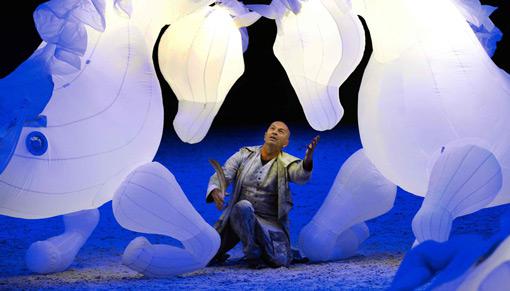

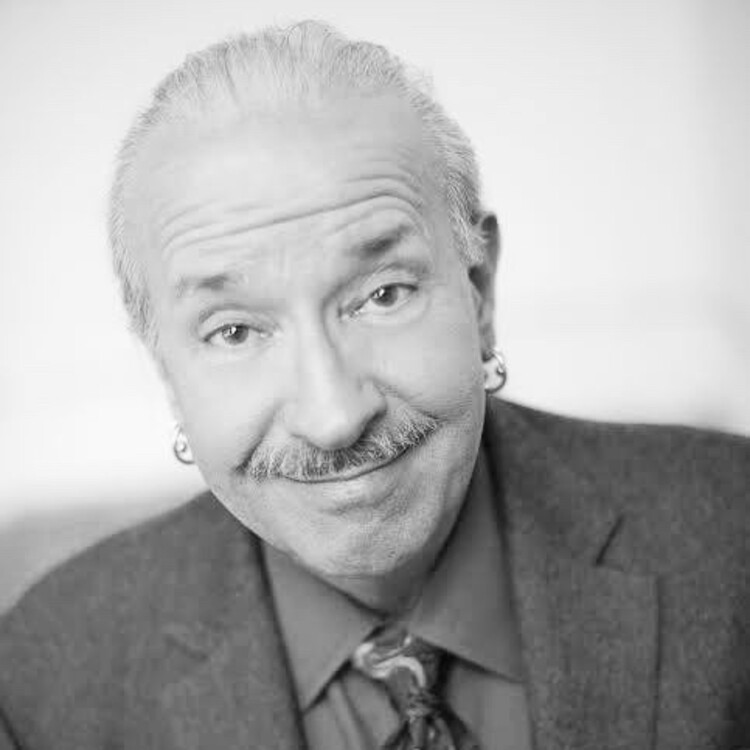


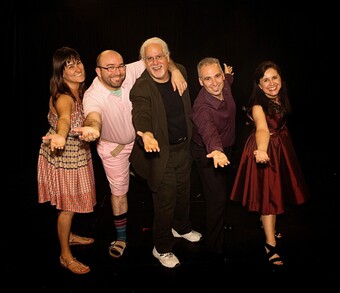

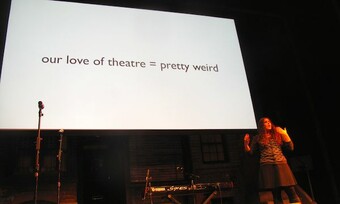

Comments
The article is just the start of the conversation—we want to know what you think about this subject, too! HowlRound is a space for knowledge-sharing, and we welcome spirited, thoughtful, and on-topic dialogue. Find our full comments policy here
I have my eye on the Philadelphia theater scene. FringeArts now has a permanent home with a performance space and a fancy restaurant. This begs the question, is a fringe festival still on the fringes when it becomes an institution? If you are interested in Philly playwrights then read "The Philadelphia Connection: Conversations with Playwrights" by B. J. Burton. I wish there was an anthology of their plays to serve as a companion book.